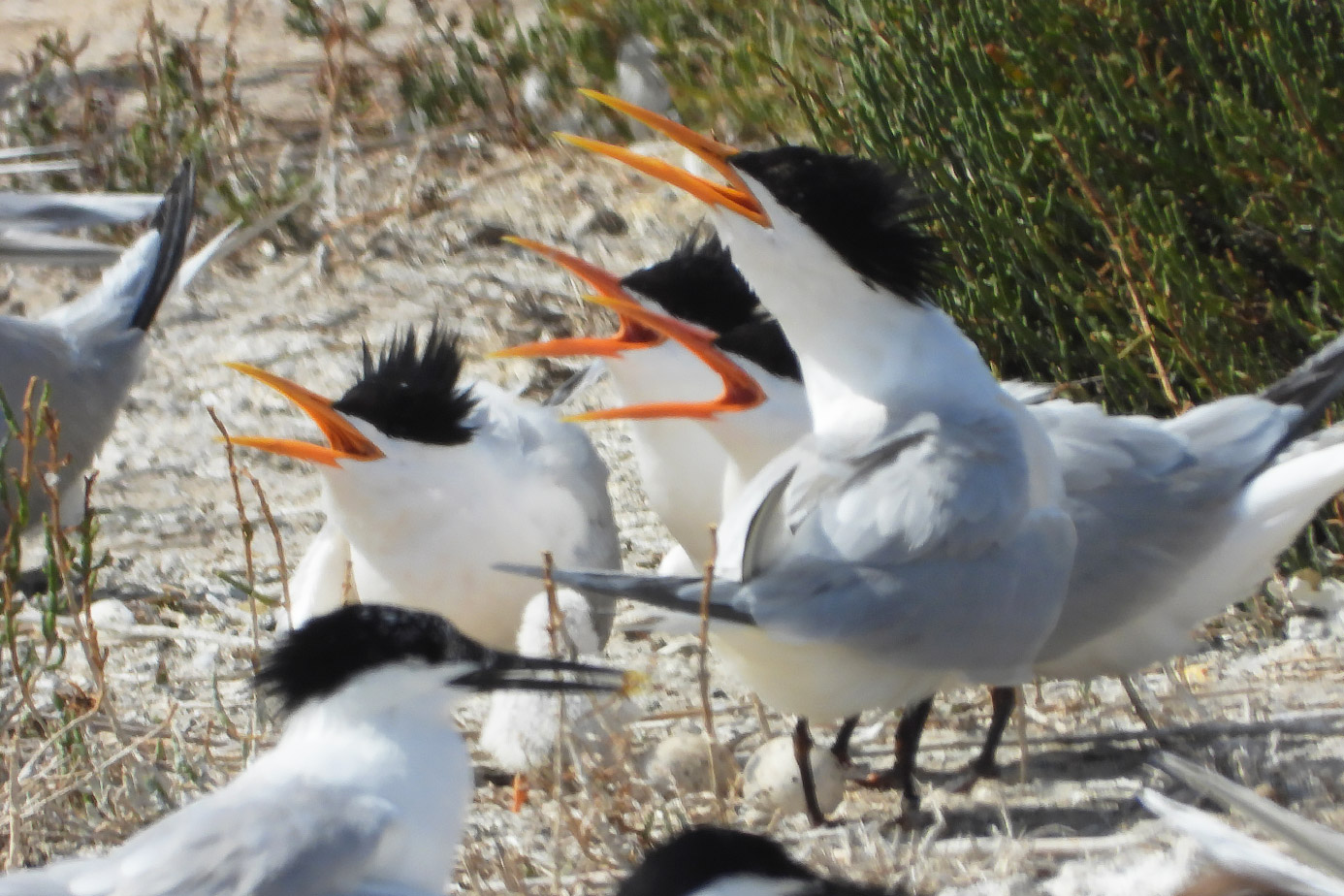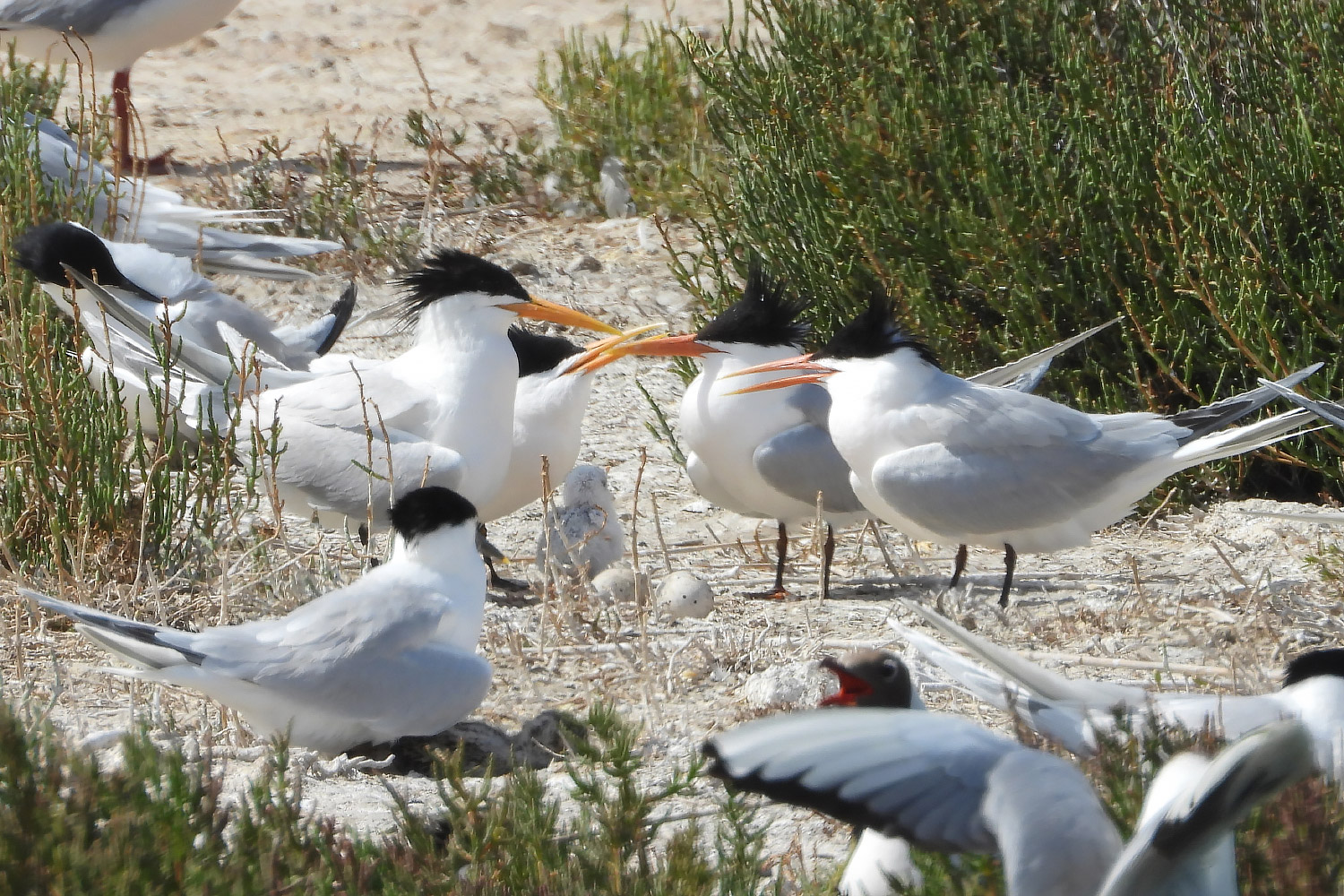Elegant Tern has bred in eastern Spain since 2009, with pure pairs nesting during successive breeding seasons up to 2018, rearing seven juveniles at the coastal stretch of l'Albufera de Valencia. This year, 2019, the presence of five adult Elegant Terns – three females and two males – resulted in the formation of two nesting pairs in the same season for the first time.
Spring arrivals came in early April: four adults were present on 5-6th, with a fifth joining on 30th. Two terns seemed to be paired already on arrival – one male was the bird regularly recorded in Spain and south-east France since 2002 (when it was ringed as an adult), which has been confirmed as an Elegant Tern by genetic analysis. This pair performed copulation on 17 April, but it seems their first clutch was lost during a severe storm system from 19-23 April that caused nest abandonment in other tern species.

Four Elegant Terns attending a co-operative nest containing three eggs, laid by three females in June 2019 (Ana Abad).
Further copulation by this pair was observed on 4 May, followed by nest attendance and incubation after 5 May. A third tern, a female, joined this pair to form a trio at their nest and engaged in egg incubation after 7 May. Two other terns present at the same site initiated ground courtship on 15 May, including food begging and nest scraping close to the nest already attended.
From 16 May, all terns started to perform nest relief at a single nest, indicative of attachment of extra birds to the mated pair at their nest – we assume that a second egg was subsequently laid since adults relieved one another during incubation and showed reciprocal acceptance thereafter (albeit this second egg was only confirmed with certainty later, on 31 May). One chick hatched from this nest on 4 June and it was brooded by all terns attending the nest.
Unexpectedly a new egg was laid at the nest on 5 June. This third egg was probably laid by the unpaired female, which firstly engaged as a trio. The single chick showed signs of sickness shortly after hatching, sometimes refusing to be fed, and eventually died on 11 June. During the two days following the death of the chick, four to five adults lingered around the nest but gradually lost interest in the incubation of the two remaining eggs. On 14 June both eggs had disappeared. Nearly all Elegant Terns departed from the site soon after this date and single individuals were sighted from 16 June until 1 July, when the last record was made.
This was the ninth season in a row where Elegant Terns have nested in eastern Spain but breeding failure had not happened since 2011, again involving a sickly chick. The habitat at l'Albufera de Valencia, of depositional coastal plains forming a continuous barrier island lagoon complex along both sides of the River Turia mouth, in the inner Gulf of Valencia in the western Mediterranean, hosts one of the biggest tern colonies in Spain (the only larger ones are at the Ebro Delta). These terneries are mostly composed of Common and Sandwich Terns, each species reaching 1,500-2,500 nesting pairs in recent years. These are based at a few favoured sites within this coastal stretch, including the renowned Racó de l'Olla saltmarsh and Els Moros marshes.

Despite promising signs, the chick soon became sickly after hatching and died within a week, followed by egg disappearance and nesting failure (Ana Abad).
The coastal lagoons provide nutrients to the sea, which is traditionally rich with clupeid fish, namely Pilchard and Anchovy, on which the terns rely heavily. However, the tern colonies at l'Albufera de Valencia have been in decline for the last decade, starting from low productivity to colony desertion and increased adult mortality. Indeed, this year the colony size of both Common and Sandwich Terns reached its lowest total for the last 25 years, with only a few tens of chicks surviving to fledging. The observed population crash in terns seems related to food shortages, particularly due to the apparent lack of clupeid fish in the sea in recent years.
Conversely, populations of other species nesting near the terns at the same site, such as Black-headed Gull, Mediterranean Gull and Gull-billed Tern – which forage in the marsh habitats during the breeding season – are showing sustained figures or even moderate increases over the same period. Fluctuations of clupeid fish populations in the Mediterranean are not well understood but are apparently linked to environmental problems, local overfishing, response to invasive species, and climate change.
One of the hypotheses explaining the presence of Elegant Tern in Europe relies on recent dramatic population fluctuations, as well as large-scale migrations to new breeding areas, caused by declines in their food resources (eg fish stocks) linked to overfishing, El Niño events and sea surface temperature anomalies in both nesting and wintering waters on the Pacific seaboard. Whatever the case, those Elegant Terns trying to thrive in eastern Spain are facing similar threats here to those that probably led them to cross the Atlantic in the first place.
References
BirdLife International. 2018. Thalasseus elegans. The IUCN Red List of Threatened Species 2018. http://dx.doi.org/10.2305/IUCN.UK.2018-2.RLTS.T22694552A132559886.en..
Dies, J I, Chardí, M, & Abad, A. 2019. Elegant Terns breeding at l’Albufera de Valencia, Spain. British Birds 112: 110-117.
Dies, J I, & Dies, B. 2017. Patterns of resource utilization during chick rearing season by gulls and terns breeding in a Mediterranean lagoon. Nemus: revista de l'Ateneu de Natura 7: 31-38.
Dufour, P, Pons, J-M, Collinson, M J, Hamza, A, Gernigon, J, Dies, J I, Sourrouille, P, & Crochet, P-A. 2017. Multi-locus barcoding confirms the occurrence of Elegant Tern in Western Europe. Journal of Ornithology 158: 351–361.
Ruiz, J, Macías, D, Rincón, M M, Pascual, A, Catalán, I A, & Navarro, G. 2013. Recruiting at the edge: kinetic energy inhibits anchovy populations in the Western Mediterranean. PloS One, 8(2), e55523.
Stoddart, A, & Batty, C. 2019. The Elegant Tern in Britain and Europe. British Birds 112: 99-109.


